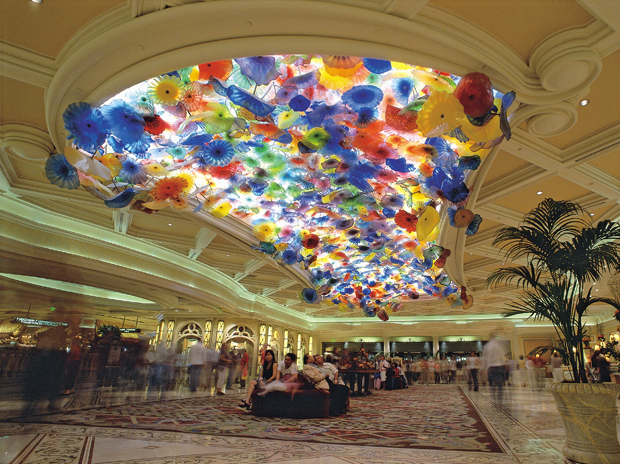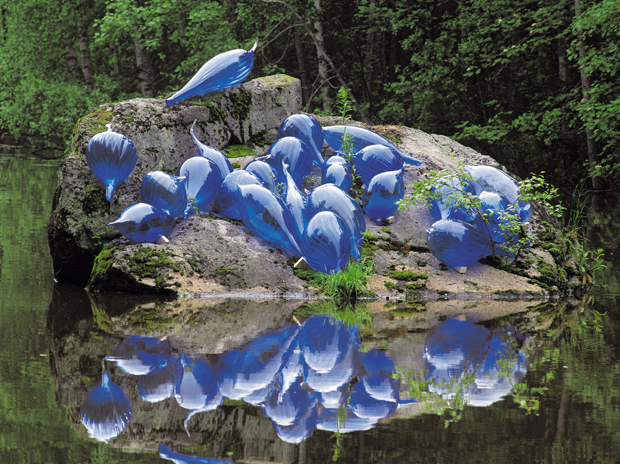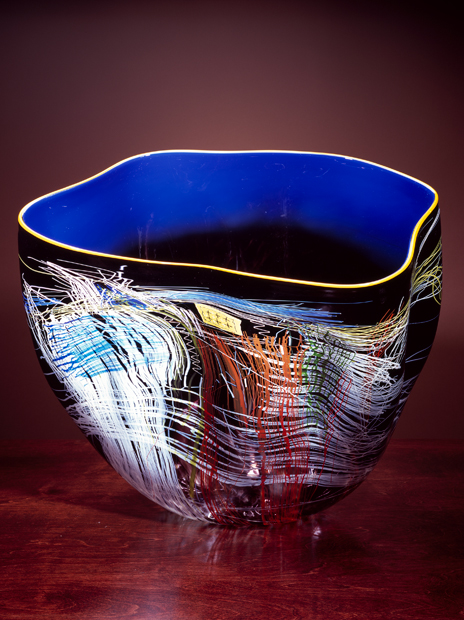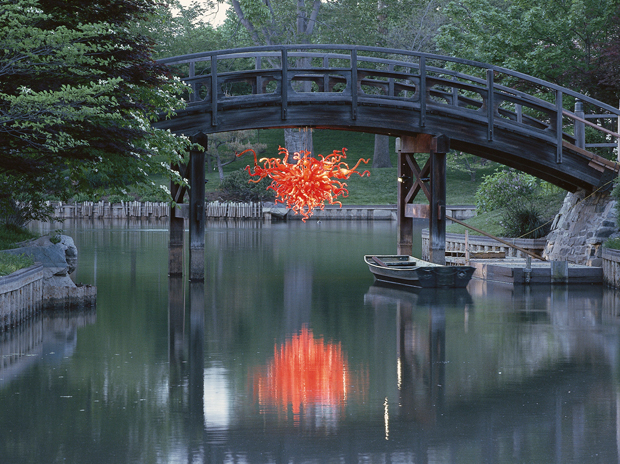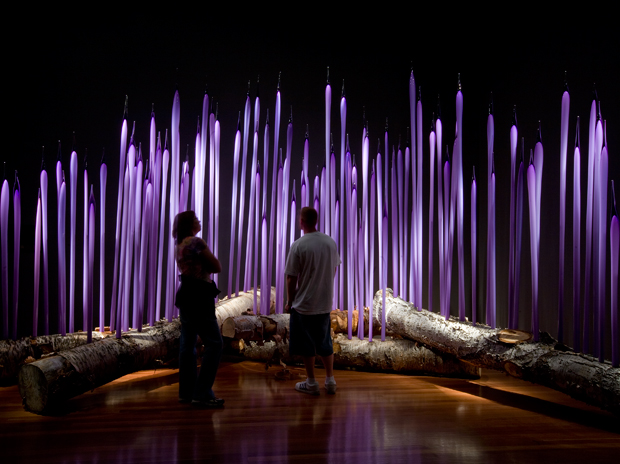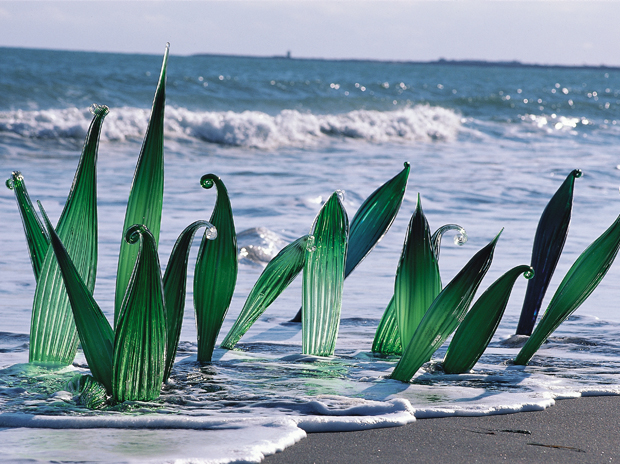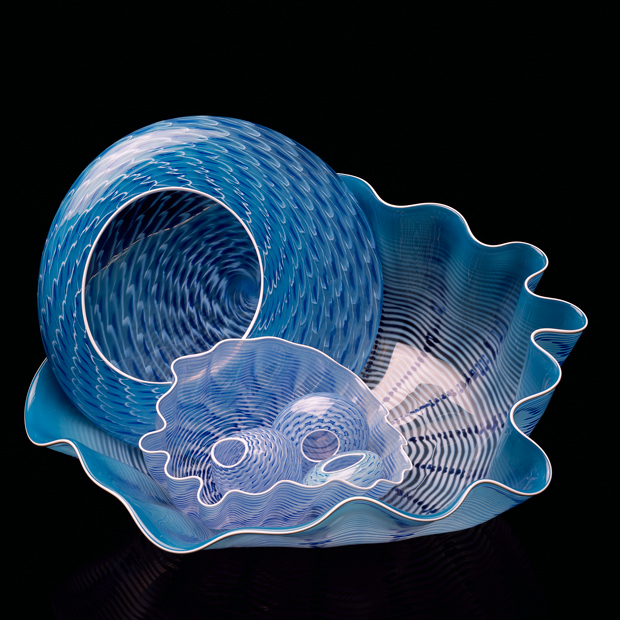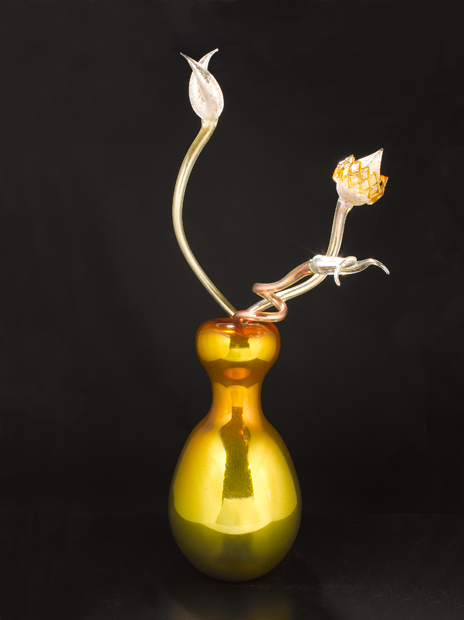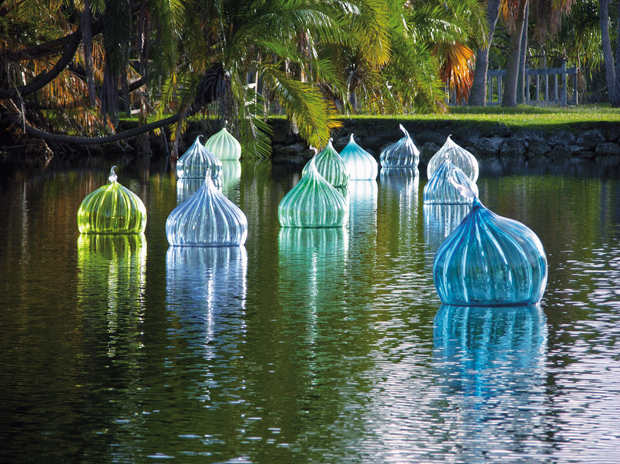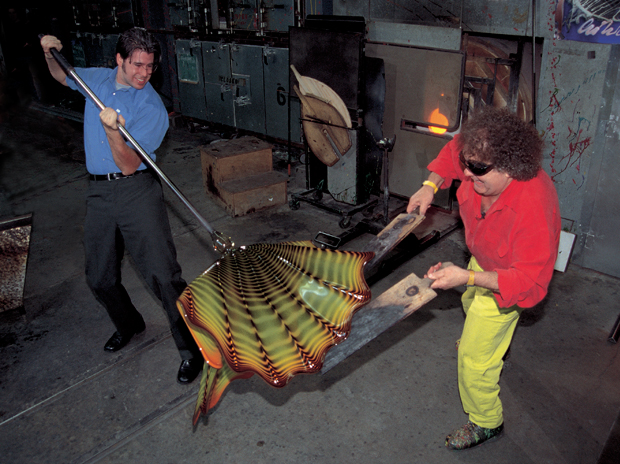
Glass is normally something that we look through. It is the means through which we mediate and in which we contain so much of our modern life - the television, the computer screen, the car windshield, and our precious commodities of art, food, wine and perfume. In the history of man, it represents a moment of perhaps unsurpassed invention - the molding of an utterly quotidian substance to the rapacious functional demands of our constant evolution. In our clamor, the beauty of glass - the extraordinary duality of its relationship with light, which both passes through and also allows itself to be captured - is one often ignored. However, in an extraordinary career spanning forty years, Dale Chihuly’s unique personal connection with this beauty has constantly pushed the boundaries of what art can do with it.
Chihuly has been refining his mastery over this most delicate of materials since being drawn to the process of glassblowing in the 1960s during his graduate and post-graduate studies in interior design and architecture. This culminated in a life-changing and career-defining Fulbright Scholarship to study glassblowing at the legendary Venini glass factory on the island of Murano in Venice in Italy, a city considered the centre of European glasswork since the thirteenth century. Many cite this experience, where he experienced at first hand the teamwork required by the scale and intricacy of the work, and his uniquely generous artistic sensibility with inspiring the multi-talented collaborative process with which he has been creating his masterpieces ever since. With this he has been able to expand his production capacity and build a creative empire whose influence and value extends far beyond his native North West America. Since he embraced these groundbreaking techniques full time in the 1970s, he has been able to construct in breathtaking detail the enormous pieces with which he is credited with taking the form of blown glass into the field of installation art and establishing it in the palate of contemporary artistic expression.
The prolific output from Chihuly’s enormous glassworks and studio in Seattle ranges from small ornamental pieces to the vast ceiling adornments, chandeliers and towers with which he has become most closely associated. Shapes teased sinuously from brilliantly colored glass cluster and tangle with themselves, forming seemingly other-worldly stems, fruit and blossoms which at the same time invoke a sense of organic intimacy and even kinship. The exquisite translucence of his expertly blown and intricately patterned glass seems to draw in and trap sunlight in many of his pieces, which hum with the enormity of this energy. The field of familiarly alien leaves and rosettes that we see in his Fiori di Como ceiling piece at the Bellagio in Las Vegas is at once bewildering and utterly tranquil. Arriving in the lobby of this iconic Vegas casino and hotel complex, one is drawn into contrasting brilliant blues, yellows, greens and reds jostling in the powerful white backlight. This floating riot seems most reminiscent of lush underwater still photography of the myriad schools of tropical fish flashing and flaunting around the coral beneath a burning Pacific sun.
Chihuly’s lasting artistic legacy can perhaps best be seen in the public installations of his work inspired by, and designed and often produced in the illustrious setting where they have been exhibited. Lending an incredibly organic sensitivity to the relationship between the place and his masterpiece, works such as the extraordinary Blue and White Towers in his Light of Jerusalem exhibition, or the roof hangings that have swam and floated above New York’s Grand Central Station and the Victoria and Albert Museum in London, explode in an extraordinary snapshot of life’s true dynamism. He utilizes the transparency of glass to its fullest potential, with daylight itself illuminating and animating his languorously fluid shapes through the course of the day. At night, he lights his work so that it exudes a sense of inordinate natural power; one that the pieces’ vibrant translucence have stolen from the sun to defy the moon.
Dale Chihuly takes us, quite simply, from translucence and transparency to moments of sheer transcendence - of the rules of artistic categorization, the very methods of his medium, nature’s own organic forms, what we think of as glass and light, and their unique relationship.
- Ben Stewart
Dale Chihuly
Address: 1111 NW 50th Street
Seattle, 98107-5120
Tel: 206 781 1906
Website: www.dalechihuly.com
Photo Credit: Dale Chihuly 1:
Fiori di Como, 1998
70 x30 x 12'
Bellagio, Las Vegas, Nevada
Dale Chihuly 2:
Belugas and Seal Pups, 1995
Nuutajärvi, Finland
Photo by Russell Johnson
Dale Chihuly 3:
Black Lapis Soft Cylinder with Lemon Lip Wrap, 2006
26 x 28 x 21"
Photo by Terry Rishel
Dale Chihuly 4:
Japanese Bridge Chandelier, 2006
4½ x 8 x 7'
Missouri Botanical Garden, St. Louis, Missouri
Photo by Terry Rishel
Dale Chihuly 5:
Green Ferns, 2000
Óseyrarsandur, Iceland
Photo by Terry Rishel
Dale Chihuly 6:
Neodymium Reeds, 2008
de Young Museum, San Francisco
Photo by Teresa Nouri Rishel
Dale Chihuly 7:
Pale Blue Seaform Set with Astral White Lip Wraps, 2003
11 x 23 x 20"
Photo by Scott M. Leen
Dale Chihuly 8:
Silvered Amber Ikebana with Three Taupe Stems, 2010
73 x 36 x 25"
Photo by David Emery
Dale Chihuly 9:
Glade Lake Walla Wallas, 2005
Fairchild Tropical Botanic Garden, Coral Gables, Florida
Photo by Terry Rishel
Dale Chihuly and James Mongrain (left) 10:
Boathouse hotshop, Seattle, Washington
Photo by Scott M. Leen
Chihuly has been refining his mastery over this most delicate of materials since being drawn to the process of glassblowing in the 1960s during his graduate and post-graduate studies in interior design and architecture. This culminated in a life-changing and career-defining Fulbright Scholarship to study glassblowing at the legendary Venini glass factory on the island of Murano in Venice in Italy, a city considered the centre of European glasswork since the thirteenth century. Many cite this experience, where he experienced at first hand the teamwork required by the scale and intricacy of the work, and his uniquely generous artistic sensibility with inspiring the multi-talented collaborative process with which he has been creating his masterpieces ever since. With this he has been able to expand his production capacity and build a creative empire whose influence and value extends far beyond his native North West America. Since he embraced these groundbreaking techniques full time in the 1970s, he has been able to construct in breathtaking detail the enormous pieces with which he is credited with taking the form of blown glass into the field of installation art and establishing it in the palate of contemporary artistic expression.
The prolific output from Chihuly’s enormous glassworks and studio in Seattle ranges from small ornamental pieces to the vast ceiling adornments, chandeliers and towers with which he has become most closely associated. Shapes teased sinuously from brilliantly colored glass cluster and tangle with themselves, forming seemingly other-worldly stems, fruit and blossoms which at the same time invoke a sense of organic intimacy and even kinship. The exquisite translucence of his expertly blown and intricately patterned glass seems to draw in and trap sunlight in many of his pieces, which hum with the enormity of this energy. The field of familiarly alien leaves and rosettes that we see in his Fiori di Como ceiling piece at the Bellagio in Las Vegas is at once bewildering and utterly tranquil. Arriving in the lobby of this iconic Vegas casino and hotel complex, one is drawn into contrasting brilliant blues, yellows, greens and reds jostling in the powerful white backlight. This floating riot seems most reminiscent of lush underwater still photography of the myriad schools of tropical fish flashing and flaunting around the coral beneath a burning Pacific sun.
Chihuly’s lasting artistic legacy can perhaps best be seen in the public installations of his work inspired by, and designed and often produced in the illustrious setting where they have been exhibited. Lending an incredibly organic sensitivity to the relationship between the place and his masterpiece, works such as the extraordinary Blue and White Towers in his Light of Jerusalem exhibition, or the roof hangings that have swam and floated above New York’s Grand Central Station and the Victoria and Albert Museum in London, explode in an extraordinary snapshot of life’s true dynamism. He utilizes the transparency of glass to its fullest potential, with daylight itself illuminating and animating his languorously fluid shapes through the course of the day. At night, he lights his work so that it exudes a sense of inordinate natural power; one that the pieces’ vibrant translucence have stolen from the sun to defy the moon.
Dale Chihuly takes us, quite simply, from translucence and transparency to moments of sheer transcendence - of the rules of artistic categorization, the very methods of his medium, nature’s own organic forms, what we think of as glass and light, and their unique relationship.
- Ben Stewart
Dale Chihuly
Address: 1111 NW 50th Street
Seattle, 98107-5120
Tel: 206 781 1906
Website: www.dalechihuly.com
Photo Credit: Dale Chihuly 1:
Fiori di Como, 1998
70 x30 x 12'
Bellagio, Las Vegas, Nevada
Dale Chihuly 2:
Belugas and Seal Pups, 1995
Nuutajärvi, Finland
Photo by Russell Johnson
Dale Chihuly 3:
Black Lapis Soft Cylinder with Lemon Lip Wrap, 2006
26 x 28 x 21"
Photo by Terry Rishel
Dale Chihuly 4:
Japanese Bridge Chandelier, 2006
4½ x 8 x 7'
Missouri Botanical Garden, St. Louis, Missouri
Photo by Terry Rishel
Dale Chihuly 5:
Green Ferns, 2000
Óseyrarsandur, Iceland
Photo by Terry Rishel
Dale Chihuly 6:
Neodymium Reeds, 2008
de Young Museum, San Francisco
Photo by Teresa Nouri Rishel
Dale Chihuly 7:
Pale Blue Seaform Set with Astral White Lip Wraps, 2003
11 x 23 x 20"
Photo by Scott M. Leen
Dale Chihuly 8:
Silvered Amber Ikebana with Three Taupe Stems, 2010
73 x 36 x 25"
Photo by David Emery
Dale Chihuly 9:
Glade Lake Walla Wallas, 2005
Fairchild Tropical Botanic Garden, Coral Gables, Florida
Photo by Terry Rishel
Dale Chihuly and James Mongrain (left) 10:
Boathouse hotshop, Seattle, Washington
Photo by Scott M. Leen
Dale Chihuly




